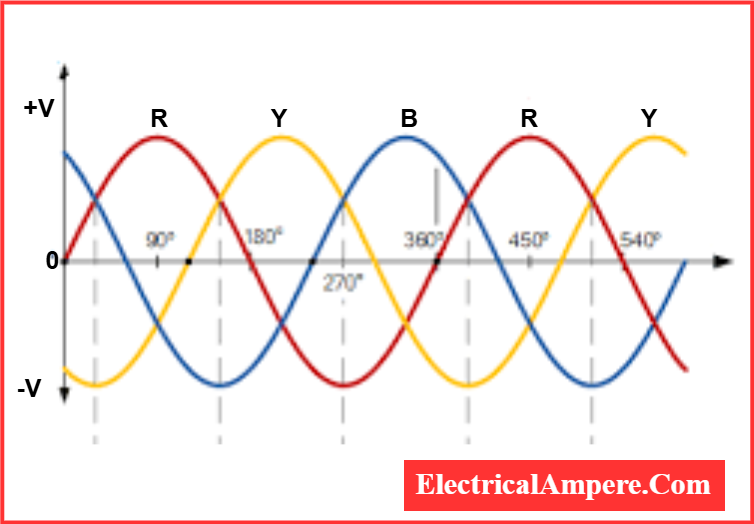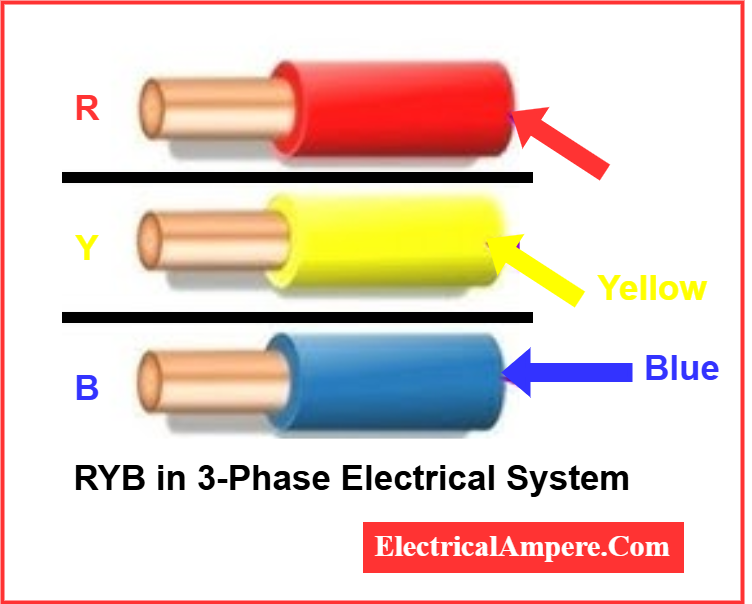Discover what RYB in electrical means, its full form, and why red, yellow, and blue are used in 3-phase systems. Learn about RYB color coding, its significance, and how it ensures safety and phase identification in electrical connections.
In electrical engineering, especially in three-phase systems, the term RYB in electrical is widely used. But what exactly does RYB mean? Why are these specific colors—Red, Yellow, and Blue—used? And what’s the significance of this color-coded system in real-world applications?
RYB Full Form in Electrical
The RYB full form stands for Red, Yellow, and Blue. These colors represent the three different phases in a three-phase electrical system. It’s also known as the R Y B phase or simply the RYB phase.
Each color corresponds to one phase:
- R – Red Phase
- Y – Yellow Phase
- B – Blue Phase
This color-coded representation is essential for identifying and connecting the right phases during installations and maintenance.

Why Color Coding of Phases is Essential in 3-Phase Electrical Systems?
In a 3-phase electrical system, each phase—Red (R), Yellow (Y), and Blue (B)—carries current at the same frequency and voltage, but with a 120° phase difference. A common question arises: If all three are phases, why should they be identified separately?
The answer lies in clarity, safety, and system reliability. Suppose you need to change the phase sequence—whether during maintenance, troubleshooting, or motor rotation correction. If each phase wire is color-coded distinctly (red, yellow, blue), it becomes easy to identify and modify the connections without confusion.
On the other hand, imagine all phase wires are of the same color. In such cases, making changes to the phase sequence becomes not only confusing but also risky. You may lose track of which wire corresponds to which phase, leading to incorrect wiring. This can cause equipment malfunction or even damage—especially in 3-phase motors where direction of rotation is sensitive to phase sequence.
To put it simply, identifying same-phase wires without color differentiation is like trying to distinguish between identical twins without any identifying features. Even if you manage to differentiate them temporarily, doubt remains whether the distinction is accurate.
Hence, phase color coding—RYB—is more than just a standard practice. It ensures ease of maintenance, safe installation, and error-free operation in electrical systems. Recognizing phases distinctly helps avoid ambiguity and supports smoother system management in both residential and industrial setups.
Why Are Red, Yellow, and Blue Used in the 3-Phase Electrical System?
In a three-phase electrical system, the phases are commonly color-coded as Red, Yellow, and Blue (RYB). But have you ever wondered why only these three colors are used? Why not green, orange, or violet?
You might wonder—why these specific colors? Here’s why:
- Standardization: The use of RYB is a globally accepted convention, particularly under IEC and Indian electrical systems, to denote the three phases in power distribution.
- Quick Identification: These colors help electricians and engineers immediately recognize the phase sequence during installation, maintenance, or troubleshooting.
- Avoids Mistakes: Proper color coding reduces the risk of wiring errors, which could otherwise lead to short circuits, equipment damage, or unsafe conditions.
Scientific Reason Behind Using RYB
Apart from standardization, there’s also a scientific reason for choosing these specific colors. The human eye is highly sensitive to red, yellow, and blue. Our optic nerves detect these colors more effectively, even in low-light conditions.
Here’s how their wavelengths compare:
- Red: ~700 nm
- Yellow: ~550 nm
- Blue: ~400 nm
Notably, yellow’s wavelength is nearly the average of red and blue, which allows for balanced light scattering. This makes RYB colors easy to distinguish, reducing confusion on-site.
RYB Electrical Connection in 3-Phase Systems

In a 3-phase system, each phase is separated by 120 degrees. In a 3-phase setup, each color corresponds to one phase:
- R (Red) = Phase 1
- Y (Yellow) = Phase 2
- B (Blue) = Phase 3
The RYB connection helps ensure that:
- Balanced loads are applied across all three phases.
- Rotation direction of motors is maintained (important for machines and compressors).
- Correct phase sequence is followed for smooth operation of 3-phase equipment.
RYB in electrical symbol or diagram usually shows three lines marked with their respective colors and voltage relationships.
This RYB electrical connection is critical for ensuring correct phase sequence and safe equipment operation. It’s especially important when working with 3-phase voltage systems, typically ranging from 360V to 440V.
How to Calculate RYB Phase Voltage in Electrical?
To calculate RYB phase voltages, you’ll use:
RYB in Electrical Formula:
For line-to-line (phase-to-phase) voltages in a 3-phase system:

Where:
- VRY is the line voltage between Red and Yellow phases
- Vph is the phase voltage
This formula applies similarly to YB and BR line voltages.

Where:
- VYB = Line voltage between Yellow and Blue phases
- Vph== Phase voltage

Where:
- VBR= Line voltage between Blue and Red phases
- Vph = Phase voltage
3-Phase Voltage Range
In most systems:
- Phase voltage (line to neutral) = 230V (in India)
- Line voltage (between any two phases, like RY) = 400V (approx.)
This voltage difference is why correct RYB electrical connection is vital—especially for sensitive equipment.
Advantages of RYB Phase Segregation in Electrical
Using a standardized RYB system has several benefits:
1. Improved Safety
Clear identification of phases reduces the risk of accidents during maintenance.
2. Efficient Troubleshooting
Technicians can quickly locate phase faults or imbalance issues.
3. Proper Load Distribution
Helps evenly distribute loads across all three phases, preventing overloads.
4. Supports Motor Direction Control
Correct phase sequence ensures motors rotate in the intended direction.
Key Takeaways
- RYB in electrical stands for Red, Yellow, and Blue phases in a 3-phase system.
- It’s crucial for identifying, connecting, and maintaining three-phase circuits.
- The RYB phase system enhances safety, efficiency, and standardization.
- Formula-based calculations ensure correct voltage interpretation.
- 3-phase voltage range typically falls around 400V (line) and 230V (phase).
Conclusion
Understanding RYB in electrical systems is foundational for working with three-phase power. Whether you’re a student, engineer, or technician, knowing the importance of RYB full form, electrical symbols, and voltage formulas will ensure safe and accurate electrical connections.
Read Next: